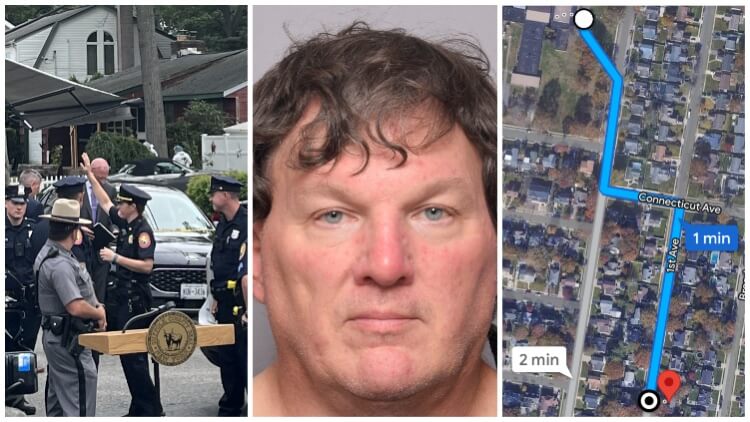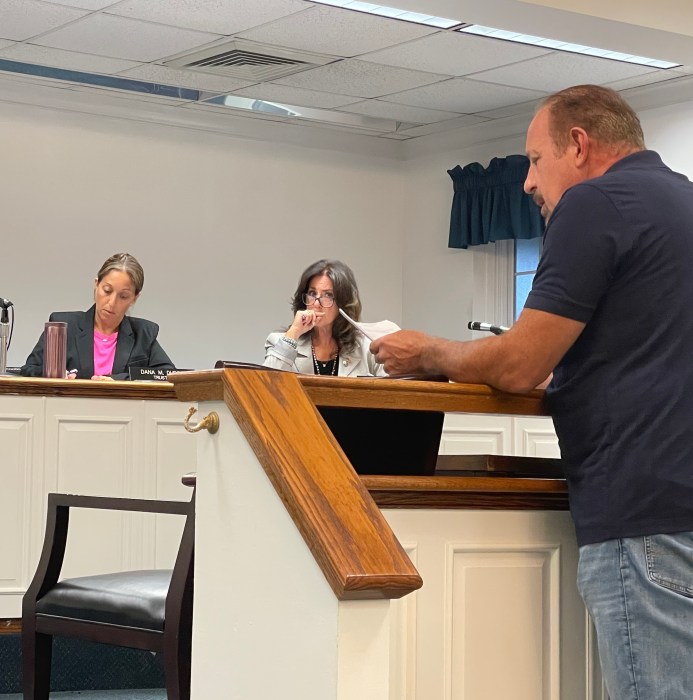The accused Gilgo Beach serial killer operated right under the nose of Nassau County police, whose former academy trained countless cadets and housed elite investigative units for 15 years — two blocks from the suspect’s home.
Rex Heuerman, the 59-year-old married architect and father of two who pleaded not guilty to three counts of murder Friday and is suspected of killing at least one more, lived in his childhood home a third of a mile away from a school that served as the Nassau police academy from 2006 until 2021, while the murders he’s accused of occurred between 2007 and 2010. The former academy was also home to the department’s Real-Time Intelligence system, an initiative that Nassau Police Commissioner Patrick Ryder spearheaded when he was commanding officer of the Asset Forfeiture Unit.
“I think he would have especially enjoyed the fact he was doing this under the nose of the police,” Dr. Carole Lieberman, a forensic psychiatrist said of Heuermann. “Because he liked to think that he is smarter than everybody else … He loves feeling that he is pulling the wool over on people. And the police having their offices so close to his house gave him an extra thrill, I’m sure.”
Heuerman’s home is located at 105 1st Avenue in Massapequa Park, a community well known for being home to many current and former members of various law enforcement agencies. The department had run its academy out of the former elementary school located at 200 2nd Avenue — a 5-minute walk from the notorious suspect’s residence. Investigators believe at least one of the murders occurred in the home, News12 Long Island reported, citing anonymous sources.
The proximity is striking, considering the case against Heuermann shows he defies the myth of the super-genius serial killer, allegedly leaving a trail of cell phone records, DNA evidence and eyewitness description of his physical appearance and vehicle for police to follow, despite speculation that he was skilled at avoiding detection. The police academy fell within “the box” of cell towers that the FBI pinpointed as being the likely home of the assailant in 2012. Heuermann appears to have hid in plain sight under the guise of being a normal suburban dad who commuted to Manhattan for work.
“To think that the Suffolk [County police] had a description of the suspect, his vehicle, knew that the phone pinged in Massapequa, and we realized that the suspect lived around the corner from the Nassau police academy, is wild,” said Joseph Giacalone, a retired NYPD sergeant and former commanding officer of the Bronx cold case squad. “It probably gave him an extra kick knowing that the Nassau cops were there.”
Nassau police have been mum about the Gilgo Beach case over the past decade since the remains were found on Ocean Parkway, as Suffolk was the lead agency on the case. But two of the 11 sets of remains found along Ocean Parkway were on the Nassau side of the Jones Beach barrier island. They include the partial remains of a victim known as Fire Island Jane Doe whose legs were initially found on the neighboring barrier beach in 1996 and whose additional extremities were found in 2011 near Tobay Beach in 2011. Also found on the Nassau side in 2011 were the skeletonized extremities of a victim known as Peaches, whose body was first found stuffed in a bin at Hempstead Lake State Park in 1997 — and whose unidentified toddler daughter was found on the Suffolk half of Ocean Parkway in 2011, around the same time that Peaches’ additional remains were found near Jones Beach.
During a July 14 news conference discussing the case, Suffolk County District Attorney Ray Tierney noted that Ryder kept under wraps his assistance to the Gilgo Beach Homicide Investigation Task Force and its precursors dating back to when the commissioner was a sergeant.
“Whenever the task force needed something to be done, Pat Ryder would do it, and he would do it quietly without much fanfare,” said Tierney. “We knew he would keep the confidentiality of our grand jury and our investigation.”
Since Nassau police moved its academy out of the school house two years ago, the building is now home to a school for special needs children. The effort for NCPD to move from the Massapequa Park former elementary school campus to a modern $54 million academy it had built on the Nassau Community College campus was tied to a coverup scandal. Three police commanders, including a former deputy commissioner, were convicted of helping cover up a burglary committed by the son of a man who served on the board of the Nassau County Police Foundation, a nonprofit created in 2008 to fundraise for building the new academy. The prosecution was launched following a 2013 Press investigation. Two of the convicted cops were spared prison time, but one was sentenced to two months in jail.
As for the special unit Ryder created next to the alleged serial killer’s house, the Real-Time Intelligence system is designed to expedite the sharing of key information with officers and is credited with helping officers make arrests that have improved the county’s crime statistics. The AFU funds such initiatives with homes, vehicles, and money seized from criminal investigations and is designed to deprive criminals of their proceeds, but the practice has drawn criticism since defendants sometimes have assets seized without having been convicted and then have to sue the police in civil court to get their property back.
Nassau police did not respond to multiple requests for comment on this story. Heuermann’s block has been a crime scene for a week, as investigators continue searching his home and other places linked to the alleged serial killer and reportedly compare his DNA to unsolved cases nationwide, well beyond his Massapequa Park neighborhood.
Related Story: Red Herrings Among Tips in Long Island Serial Killer Case
Related Story: Gilgo Beach Serial Killer Suspect Rex Heuermann an ‘Ogre’ Who Defies Supervillain Myth
Related Story: Who is The Girl With The Peach Tattoo?
For more Long Island Serial Killer coverage visit longislandpress.com/tag/long-island-serial-killer


































